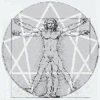“The differences in the notes or the differences in the pitch of the notes are called intervals. We see that there are three kinds of intervals in the octave: 9/8, 10/9, and 16/15, which in whole numbers correspond to 405, 400, and 384. The smallest interval 16/15 occurs between MI AND FA and between si and do. These are precisely the places of retardation in the octave. Fragments: Seven
“In this manner twenty notes are obtained, eight of which are fundamental: do, re, mi, fa, sol, la, si, do; and twelve intermediate: two between each of the following two notes: do-re re-mi fa-sol sol-la la-si; and one between each of the following two notes: mi-fa si-do. “But in practice, that is, in music, instead of twelve intermediate semitones only five are taken, that is one semitone between: do-re re-mi fa-sol sol-la la-si. “Between MI AND FA and between si and do the semitone is not taken at all. Fragments: Seven
“What precisely does happen at the moment of the retardation of vibrations? A deviation from the original direction takes place. The octave begins in the direction shown by the arrow: “But a deviation takes place between MI AND FA; the line begun at do changes its direction and through fa, sol, la, and si it descends at an angle to its original direction, shown by the first three notes. Between si and do the second ‘interval’ occurs — a fresh deviation, a further change of direction. Fragments: Seven
“In an ascending octave the first ‘interval’ comes between MI AND FA. If corresponding additional energy enters at this point the octave will develop without hindrance to si, but between si and do it needs a much stronger ‘additional shock’ for its right development than between MI AND FA, because the vibrations of the octave at this point are of a considerably higher pitch and to overcome a check in the development of the octave a greater intensity is needed. Fragments: Seven
“It must be observed that, although there are six ‘intervals’ in these three octaves, only three of them actually require to be supplemented from outside. The first ‘interval’ between do and si is filled by the will of the Absolute. The second ‘interval’ do-si is filled by the influence of the sun’s mass upon radiations passing through it. And the third ‘interval’ do-si is filled by the action of the earth’s mass upon radiations passing through it. Only the ‘intervals’ between fa and mi have to be filled by ‘additional shocks.’ These ‘additional shocks’ can come either from other octaves which pass across the given point or from parallel octaves which start from higher points. We know nothing about the nature of the ‘shock’ between mi-fa in the first octaoctave Absolute-Sun. But the ‘shock’ in the octave Sun-Earth is organic life on earth, that is, the three notes la, sol, fa of the octave which starts in the sun. The nature of the ‘shock’ between MI AND FA in the octave Earth-Moon is unknown to us. Fragments: Nine
“We have spoken earlier of the law of octaves, of the fact that every process, no matter upon what scale it takes place, is completely determined in its gradual development by the law of the structure of the seven-tone scale. In connection with this it has been pointed out that every note, every tone, if taken on another scale is again a whole octave. The ‘intervals’ between MI AND FA and between si and do which cannot be filled by the intensity of the energy of the process in operation, and which require an outside ‘shock,’ outside help so to speak, connect by this very fact one process with other processes. From this it follows that the law of octaves connects all processes of the universe and, to one who knows the scales of the passage and the laws of the structure of the octave, it presents the possibility of an exact cognition of everything and every phenomenon in its essential nature and of all its interrelations with phenomena and things connected with it. Fragments: Fourteen
“At this point in our reasoning it would be entirely right to raise the question: Why is one of the ‘intervals’ which is designated by the number 3 found in its right place between the notes MI AND FA, and the other, which is designated by the number 6, found between sol and la, when its right place is between si and do. Fragments: Fourteen
that is, in one case x between MI AND FA, and in the other between sol and la, where it is not necessary. “The apparent placing of the interval in its wrong place itself shows to those who are able to read the symbol what kind of ‘shock’ is required for the passage of si to do. “In order to understand this, it is essential to recollect what was said about the role of ‘shocks’ in the processes proceeding in man and in the universe. “When we examined the application of the law of octaves to the cosmos then the step ‘sun-earth’ was represented in this way: “In relation to the three octaves of radiation it was pointed out that the passage of do to si, the filling of the interval, takes place within the organism of the sun. It was pointed out in the cosmic octave in relation to the ‘interval’ do-si that this passage is accomplished by the will of the Absolute. The passage fa-mi in the cosmic octave is accomplished mechanically with the help of a special machine which makes it possible for fa, which enters it, to acquire by a series of inner processes the characteristics of sol standing above it, without changing its note, that is, to accumulate, as it were, the inner energy for passing independently into the next note, into mi. Fragments: Fourteen

